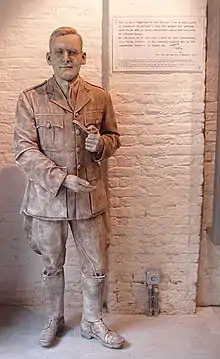Tubby Clayton
The Reverend Philip Thomas Byard Clayton CH MC FSA (known as "Tubby Clayton") (12 December 1885 – 16 December 1972) was an Anglican clergyman and the founder of Toc H.



Life and career
Philip Clayton was born in Maryborough, Queensland, Australia, to English parents[1] who brought him back to England when he was two years old. Through both his father Reginald Byard Buchanan Clayton (1845–)[2] and his mother Isabel Clayton, née Byard Sheppard (1848–1919), he is descended from George Sheppard, a clothier in Frome. He was educated at St Paul's School in London and at Exeter College, Oxford, where he obtained a First in Theology.
After ordination as a priest of the Church of England, Clayton served as curate under Cyril Forster Garbett at St Mary's Church, Portsea, from 1910 to 1915.[3] He then became an army chaplain in France and Flanders where, in 1915, he and another chaplain Rev. Neville Talbot opened "Talbot House",[4] a rest house for soldiers at Poperinge, Belgium. It became known as Toc H, this being signal terminology for "T H" or "Talbot House". It closed temporarily in 1918 when the German front had drawn too close.
The spirit of friendship fostered at Toc H across social and denominational boundaries inspired Clayton, the Rev. Dick Sheppard, and Alexander Paterson to set out in 1920 what became known as the Four points of the Toc H compass:
- Friendship ("To love widely")
- Service ("To build bravely")
- Fair-mindedness ("To think fairly")
- The Kingdom of God ("To witness humbly")
This followed the foundation of a new Toc H House in Kensington in 1919, followed by others in London, Manchester, and Southampton. The Toc H movement continued to grow in numbers and established, also, a women's league. In 1930, Clayton led Toc H into creative support of the British Empire Leprosy Relief Association.[1]
From 1922 to[5] 1962, Clayton was Vicar of All Hallows-by-the-Tower in the City of London. While working in the area, he helped to devise the Tower Hill Improvement Scheme (with Lord Wakefield of Hythe).[1] His work also brought him into contact with the East End of London and its frequently harsh and impoverished conditions. Two aspects of his work converged in 1940 when All Hallows was devastated by bombing during the Blitz and Clayton played a primary role in fundraising for its restoration, joining this to a general drive for raising money for the similarly devastated East End. In 1948, Clayton and John G. Winant (the latter, at that time, the American Ambassador to the United Kingdom) set up the Winant Clayton Volunteer Association to bring young Americans to London for volunteer work. In 1959, the association helped to send British volunteers to America to do similar work, setting up a mutual exchange scheme that has continued to this day.[6]
While remaining based at All Hallows, Clayton travelled widely in Britain and throughout the British Empire promoting Toc H and encouraging the foundation of new branches. He was also the chaplain to the British Petroleum Company - a duty which overlapped with his chaplaincy to the Anglo-Saxon tanker fleet during World War 2 (a position which he was particularly proud of).[1]
He was the subject of This Is Your Life in 1958 when he was surprised by Eamonn Andrews at the BBC Television Theatre.
Clayton died on 16 December 1972. He is honoured in The Museum of Army Chaplaincy and in the "Talbot House" in Poperinge, Belgium.
References
- Sleevenotes to Tubby Talking: informal conversations with the Rev. Dr. P. B. Clayton, Founder Padre of Toc H (Toc H LP, TOC1A)
- "Clayton, Philip Thomas Byard [Tubby] (1885–1972), Church of England clergyman and founder of the Toc H movement". Oxford Dictionary of National Biography (online ed.). Oxford University Press. 2004. doi:10.1093/ref:odnb/30940. Retrieved 21 May 2019. (Subscription or UK public library membership required.)
- The Rev P. T. B. Clayton. The Times (London, England), Tuesday, Dec 19, 1972; pg. 18; Issue 58660
- "Talbot House". Retrieved 17 September 2006.
- Crockford's Clerical Directory 1929-30 p241 London: Oxford University Press, 1929
- "Archived copy". Archived from the original on 2 May 2014. Retrieved 10 February 2012.CS1 maint: archived copy as title (link)
Further reading
- Clayton, P. T., ed. (1919). Tales of Talbot House: everyman's club in Poperinghe & Ypres, 1915–1918.
- Durham, John, ed. (1960). Talbot House to Tower Hill: an anthology of the writings of the Reverend P. B. "Tubby" Clayton.
- Harcourt, Melville (1953). Tubby Clayton: a personal saga. London: Hodder and Stoughton.
- Lever, Tresham (1971). Clayton of Toc H. London: John Murray. ISBN 0719524261.
- Nicholls, C. S. (2004). "Clayton, Philip Thomas Byard (1885–1972)". Oxford Dictionary of National Biography (online ed.). Oxford University Press. doi:10.1093/ref:odnb/30940. (Subscription or UK public library membership required.)
- Prideaux-Brune, Kenneth (1983). A Living Witness: a personal memoir of Philip Clayton. Wendover: Toc H.
- Rice, Judith & Prideaux-Brune, Kenneth (1990). Out of a Hop Loft: seventy-five years of Toc H.
External links
- Smith, M. K. "Philip 'Tubby' Clayton and Toc H". Encyclopedia of Informal Education. Retrieved 27 September 2006.
- Tubby Clayton's appearance on This Is Your Life